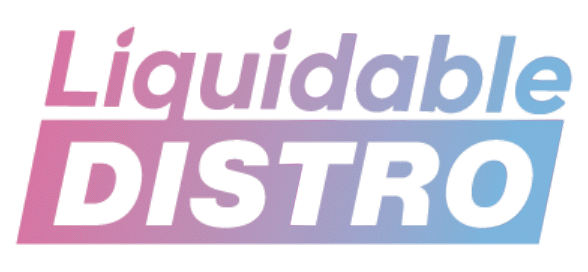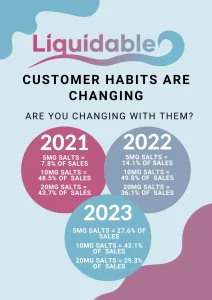The vaping industry has experienced a noticeable shift in consumer preferences over the past few years, especially in the realm of nicotine salt e-liquids. With a growing emphasis on health consciousness and a push towards reducing nicotine intake, low nicotine e-liquids have gained substantial traction. Recent sales statistics reveal a fascinating trend: a steady increase in the popularity of lower nicotine salt e-liquids, reflecting a significant change in consumer behaviour and preferences.
A Look at the Numbers: The Shift Towards Low Nicotine E-Liquids
Sales data from the past three years showcases a clear trend: a growing preference for lower nicotine salt e-liquids. Let’s delve into the specifics:
- 2021:

- 5mg Salts: 7.8% of sales
- 10mg Salts: 48.5% of sales
- 20mg Salts: 43.7% of sales
- 2022:
- 5mg Salts: 14.1% of sales
- 10mg Salts: 49.8% of sales
- 20mg Salts: 36.1% of sales
- 2023:
- 5mg Salts: 27.6% of sales
- 10mg Salts: 43.1% of sales
- 20mg Salts: 29.3% of sales
From these figures, it’s clear that the demand for 5mg nicotine salt e-liquids has nearly quadrupled over the past three years. While 10mg salts remain the most popular choice, their share has remained relatively stable. Hovering around the 43-50% mark. In contrast, the demand for 20mg salts has decreased significantly, dropping from 43.7% in 2021 to 29.3% in 2023. This trend highlights a growing consumer interest in reduced nic’ options.
Why Are Low Nicotine E-Liquids Gaining Popularity?
Several factors contribute to the rising popularity of low nicotine e-liquids:
- Health Consciousness: As awareness of the health risks associated with nicotine consumption grows, more vapers are opting for lower levels. Many individuals are looking to reduce their nicotine intake while still enjoying the experience of vaping. Leading to an increased demand for products with lower nicotine concentrations.
- Better Flavour Profiles: Lower nicotine e-liquids often provide a more robust and nuanced flavour experience. Higher nicotine levels can sometimes mask or alter the flavour of the e-liquid, whereas lower nicotine options allow for a more authentic taste. This appeals to vapers who prioritize flavour overstrength.
- Smoother Vaping Experience: Lower nicotine e-liquids typically offer a smoother throat hit, making the vaping experience more enjoyable for many users. This is particularly appealing to those who find higher nicotine levels too harsh or uncomfortable.
- Trend Towards Nicotine Reduction: There is a growing trend among vapers to gradually reduce their intake. As a result, many start with higher nicotine levels and progressively switch to lower levels as they aim to eventually wean off nicotine altogether.
- Availability and Variety: The market for low nicotine e-liquids has expanded, offering a wide range of flavours and options. This increased availability makes it easier for consumers to find products that suit their preferences and needs. Further driving the trend towards lower nicotine choices.
The Implications for the Vaping Industry
The increasing demand for low nicotine e-liquids signifies a shift in the vaping industry, with manufacturers and retailers adapting to meet this changing consumer preference. Several implications arise from this trend:
- Product Innovation: Companies are likely to invest more in developing and promoting low nicotine products. This includes experimenting with new flavours and formulations to cater to the growing market segment.
- Regulatory Landscape: The shift towards lower nicotine products may influence regulatory policies. Governments and health authorities may take note of this trend as they shape future regulations to promote safer and healthier vaping practices.
- Market Segmentation: The vaping market is becoming more segmented. With a clear distinction between users seeking high nicotine products and those opting for low options. This segmentation allows for more targeted marketing and product development strategies.
Looking Ahead
The trend towards lower nicotine e-liquids is likely to continue as more vapers seek healthier alternatives and aim to reduce their nicotine dependence. This shift presents opportunities for innovation and growth within the vaping industry. Encouraging the development of products that cater to the evolving needs and preferences of consumers.
As the vaping landscape continues to change, staying informed and adaptable will be key for both consumers and industry players. The rise of low nicotine e-liquids not only highlights a significant trend but also points towards a broader movement towards healthier lifestyle choices in the world of vaping.
In conclusion, the increasing popularity of low nicotine e-liquids reflects a growing trend among vapers towards health consciousness and a desire for a more enjoyable vaping experience. As this trend continues to evolve, it will shape the future of the vaping industry, driving innovation and influencing consumer choices for years to come.


Comments are closed